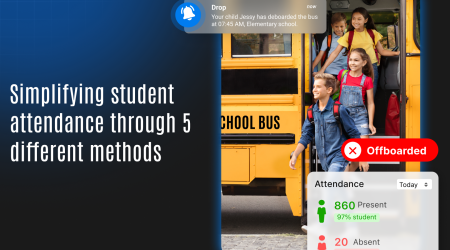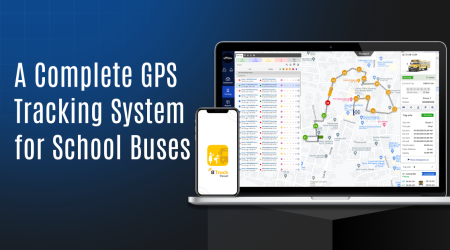How Increasing Market Reach with Co-Branded Marketing Initiatives Boosts the School Transport Business

In today’s competitive landscape, companies are constantly seeking innovative ways to expand their market reach. Let’s take an instance of a company which has successfully achieved this through co-branded marketing initiatives, particularly focusing on its school bus monitoring software. This detailed case study explores how the company has utilized these strategies to enhance its presence in the market, drive customer engagement, and increase overall sales.
Co-branded marketing involves two or more brands collaborating to create a product, service, or campaign that leverages the strengths and customer bases of each brand. This strategy can enhance brand visibility, build trust, and open new market segments. The company’s focus on co-branded initiatives has enabled it to leverage these advantages, especially in promoting its school bus routing software.
The Need for School Bus Monitoring Software
School bus monitoring software plays a critical role in ensuring the safety and efficiency of student transportation. It offers functionalities such as live GPS tracking, route optimization, and notifications for parents and school administrators. By partnering with other brands, the company has been able to amplify the reach and effectiveness of this software.
Benefits of Co-Branded Marketing for the company
1. Enhanced Brand Visibility
Co-branded marketing initiatives increase brand visibility by exposing the company to the partner brand’s audience. This increased visibility boosts recognition of the company’s products and services. A strong logo design for the co-branding can make the partnership more memorable.
2. Increased Trust and Credibility
Partnering with well-established brands enhances trust and credibility. When customers see the company collaborating with a trusted brand, they are more likely to perceive the company as reliable and reputable.
3. Access to New Markets
Co-branded initiatives provide access to new market segments that might be difficult to reach independently. By collaborating with brands that have a strong presence in specific markets, the company can tap into these new customer bases.
4. Shared Marketing Costs
Marketing campaigns can be expensive. Co-branded initiatives allow the company to share marketing costs with its partners, making it more cost-effective to run extensive campaigns.
5. Innovative Product Offerings
Co-branding often leads to innovative product offerings that combine the strengths of both brands. This can result in unique features and benefits that attract a wider audience.
Case Study: the company’s Co-Branded Marketing Success
Background
The company, a leader in technology solutions, sought to increase its market reach for its school bus monitoring software. Recognizing the potential of co-branded marketing, the company partnered with several well-known brands to enhance its visibility and credibility.
Objectives
-
Enhanced Brand Visibility
Co-branded marketing exposes the company to the partner brand’s audience, significantly increasing brand visibility and attracting new customers. This broader exposure enhances awareness of the company’s offerings.
-
Increased Trust and Credibility
Partnering with reputable brands boosts trust and credibility. Customers tend to have greater trust in the company when they observe collaborations with well-known and reputable brands.
-
Access to New Markets
Co-branded initiatives open doors to new market segments. the company can tap into the existing customer bases of its partners, reaching audiences that might have been challenging to access independently.
-
Shared Marketing Costs
Co-branded marketing allows the company to share marketing costs with its partners. This makes running extensive and impactful campaigns more cost-effective and feasible.
-
Innovative Product Offerings
Collaborating with other brands often leads to innovative product offerings. These unique products combine the strengths of both brands, attracting a wider audience with enhanced features.
Implementation Process
- Identifying Potential Partners
the company identified brands that shared its values and had a strong presence in relevant markets. These included transportation companies, educational institutions, and tech firms. - Developing Co-Branded Campaigns
Together with its partners, the company developed co-branded campaigns that highlighted the benefits of its school bus monitoring software. These campaigns included joint webinars, shared social media promotions, and collaborative content marketing. - Leveraging Partner Networks
By leveraging the networks of its partners, the company was able to reach a wider audience. The campaigns were advertised across multiple channels such as email newsletters, affiliate websites, and social media platforms. - Creating Unique Value Propositions
Each co-branded initiative featured a unique value proposition that combined the strengths of both brands. For example, a partnership with a transportation company emphasized the seamless integration of the company’s software with existing transportation management systems. - Measuring and Analyzing Results
Throughout the campaign, the company tracked key performance metrics such as website traffic, lead generation, and sales conversions. This data was analyzed to measure the success of the initiatives and identify areas for improvement.
Results
The co-branded marketing initiatives led to significant increases in brand visibility, customer engagement, and sales. The company was able to penetrate new market segments and establish itself as a trusted provider of school bus monitoring software.
Key Takeaways
1. Increased Brand Visibility
By partnering with well-known brands, the company significantly increased its brand visibility. The co-branded campaigns reached a wider audience, resulting in greater awareness of the company’s offerings.
2. Enhanced Trust and Credibility
The collaborations enhanced trust and credibility among potential customers. Seeing the company associated with reputable brands reassured customers about the quality and reliability of its products.
3. Access to New Market Segments
The co-branded initiatives allowed the company to access new market segments. By leveraging the strengths and customer bases of its partners, the company was able to reach new customers and expand its market presence.
4. Cost-Effective Marketing
Sharing marketing costs with partners made the campaigns more cost-effective. The company was able to run extensive marketing campaigns without incurring the full costs alone.
5. Innovative Product Offerings
The partnerships resulted in innovative products that leveraged the strengths of both brands. This resulted in unique features and benefits that attracted a wider audience.
Conclusion: Embracing Co-Branded Marketing for Future Growth
The company’s success with co-branded marketing initiatives highlights the potential of this strategy for increasing market reach. By collaborating with well-established brands, the company was able to enhance its visibility, credibility, and access to new market segments. The shared marketing costs and innovative product offerings further contributed to the success of the initiatives.
As the company continues to innovate and expand, co-branded marketing will remain a key strategy for driving growth. The lessons learned from these initiatives will inform future collaborations, ensuring continued success in increasing market reach and customer engagement.
By embracing co-branded marketing, the company can continue to lead the way in providing innovative and effective solutions for school bus monitoring and beyond. The future looks bright for the company as it leverages the power of collaboration to drive growth and success.


